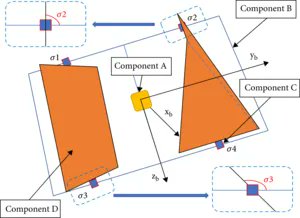Solar sailing seems like a simple concept – instead of being pushed along by the wind, as in a typical sailing ship, a spacecraft can use highly reflective said to be pushed along simply by sunlight. But as with almost all engineering challenges, that technique is much easier said than done. Sunlight can head up one side of a sail more than another, causing the ship to rotate unexpectedly.
Other unforeseen situations could arise that can also have catastrophic consequences for any mission using this propulsion technology. Luckily, there is a way to account for those situations, though it involves a lot of math. Control theory is common in system design, and now researchers at Beihang University have devised a control scheme that they think could help minimize the risk to solar sails.
Control systems are relatively easy to understand in concept. A system has a series of inputs; in the case of a solar sail, those inputs might be the solar force pushing on it from the Sun and maybe the gravity of any nearby object. That system will also have outputs the system designer wants to control, such as the distance from that object (if it’s in orbit) or the angle the solar sail is facing.
Typically the “control system” is the set of mathematical equations that takes the inputs to the system and then determines how to manipulate other internal variables to make the outputs get to a desired value. For example, if we know solar radiation is pushing on the solar sail with a force of 1000 N, we can calculate what, if any, adjustments we would need to make for the probe to maintain whatever orbit it has. UT video describing the concept of solar sailing.
While useful in all types of systems, these types of controls are especially useful in spacecraft. All spacecraft have them to one degree or another, and it is certainly not the first time someone has thought to apply a control system to a solar sail propulsion system. However, there are several disadvantages to the ones developed so far.
To understand those disadvantages, it is better first to understand the specific kind of control methodology used in the new paper recently published in Space: Science & Technology. Known as “fuzzy logic,” these systems are a contrast to standard Boolean logic that computers (and some control systems) use. Instead of the 1s and 0s of Boolean math, fuzzy logic can use any number between 0 and 1 as both an input and an output.
Using more varied numbers increases the complexity significantly, so typically there is a significant amount of training that has to go into controllers that use fuzzy logic. That training can be thought of as being similar to that associated with neural networks, a common type of AI architecture. However, there isn’t a whole lot of data available on solar sail systems, as not many of them have taken flight yet.
So any system that can lower the necessary training threshold would be a significant advance. Another UT interview details the functionality of solar sails. Instead of providing training data sets to the fuzzy logic controller, a system operator could try to model the system entirely and manipulate it using known parameters.
This would be the equivalent of having a “digital twin” of the solar sail, allowing the operators to develop new control schemes on the fly. However, according to Dr. Lin Chen and his coauthors, this type of active modeling isn’t helpful for spacecraft attitude control.
So they came up with an alternative. Their solution is known as an Intelligent Fuzzy Logic Controller Designer, which essentially designs its own fuzzy logic controller using neural network modeling. The system would automatically generate a fuzzy logic controller based on the parameters input into it.
That logic controller would allow operators to control the attitude of their solar sail system. To test this new controller, the authors did develop a computational model of an example solar sail with four distinct components, a spacecraft “kernel,” a box for the controller, a frame, and the solar sail itself. After testing their intelligent controller design on this model, they found significant improvements in the accuracy of the controller, which is extraordinarily important in control systems, at the cost of a bit slow reaction time, which isn’t too big a concern when dealing with the time scales of a solar sail.
It sounds like an elegant solution to a specific problem, and hopefully, the solar sail designers of the future will take the ideas from the paper to heart. Learn More:Beijing Institute of Technology Press – How scientist developed an intelligent fuzzy logical control to stabilize solar sail?Chen et al – Intelligent Fuzzy Control in Stabilizing Solar Sail with Individually Controllable ElementsUT – A new Kind of Solar Sail Could let us Explore Difficult Places to Reach in the Solar SystemUT – What Is A Solar Sail? Lead Image:System diagram of the solar sail modeled in the paper. Credit – Chen et al.
The post How do you Keep a Solar Sail Stable? appeared first on Universe Today. .
From: universetoday
URL: https://www.universetoday.com/158488/how-do-you-keep-a-solar-sail-stable/



